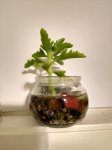gallina1594
Shohin
Like most of us, I'm sure our plant collection extends much further than our trees!
Succulents really peaked my interest in horticulture. I've always been fascinated with their ability to take extreme beatings and neglect.
I've learned that there is a HUGE difference between water roots, and roots that develop in substrate.
I'm not sure on the scientific reasons, but roots that develop in substrate, are not suited to grow in water. Say you pluck a succulent out of the ground and throw it in some water, those roots will die, but it will develop new "water roots".
I've been doing experiments on different plants, trying to figure out what plants can make this conversion. So far I've discovered that Kalanchoe blossfeldana, this varity of Crassula (still haven't been able to pin point exact name yet), and another variety of Kalanchoe called Mother of Millions.
I'm also working with a habanero clipping to see if it will develop roots. It's been in water for 2 weeks now. It shows no roots yet, but it's still very healthy.
Ive learned that to keep your hydroponic succulents happy, you need to change the water weekly, and keep the water oxygenated.
Anyone else try something similar?



Succulents really peaked my interest in horticulture. I've always been fascinated with their ability to take extreme beatings and neglect.
I've learned that there is a HUGE difference between water roots, and roots that develop in substrate.
I'm not sure on the scientific reasons, but roots that develop in substrate, are not suited to grow in water. Say you pluck a succulent out of the ground and throw it in some water, those roots will die, but it will develop new "water roots".
I've been doing experiments on different plants, trying to figure out what plants can make this conversion. So far I've discovered that Kalanchoe blossfeldana, this varity of Crassula (still haven't been able to pin point exact name yet), and another variety of Kalanchoe called Mother of Millions.
I'm also working with a habanero clipping to see if it will develop roots. It's been in water for 2 weeks now. It shows no roots yet, but it's still very healthy.
Ive learned that to keep your hydroponic succulents happy, you need to change the water weekly, and keep the water oxygenated.
Anyone else try something similar?




